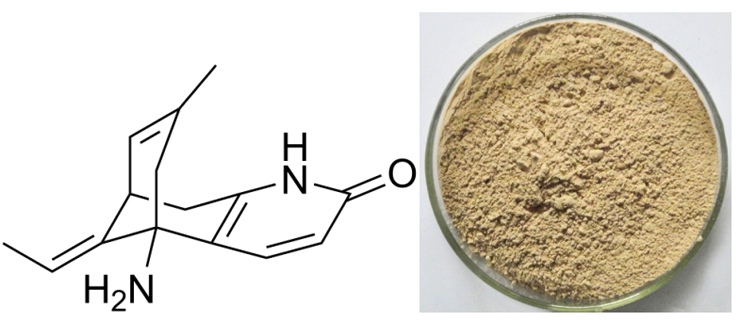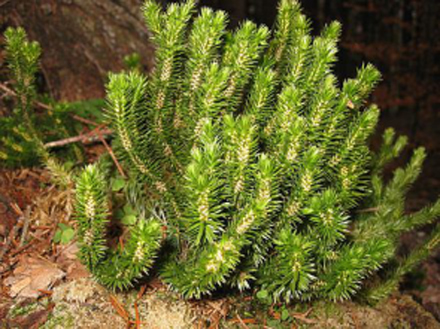High Quality Huperzine A Wholesale to Guinea
High Quality Huperzine A Wholesale to Guinea Detail:
[Latin Name]Huperzia serratum
[Source] Huperziceae whole herb from China
[Appearance]Brown to white
[Ingredient]Huperzine A
[Specification]Huperzine A 1% – 5%, HPLC
[Solubility] Soluble in chloroform, methanol, ethanol, slightly soluble in water
[Particle size] 80 Mesh
[Loss on drying] ≤5.0%
[Heavy Metal] ≤10PPM
[Pesticide residue] EC396-2005, USP 34, EP 8.0, FDA
[Storage] Store in cool & dry area, keep away from the direct light and heat.
[Shelf life] 24 Months
[Package] Packed in paper-drums and two plastic-bags inside.
[What is Huperzine A]
Huperzia is a type of moss that grows in China. It is related to club mosses (the Lycopodiaceae family) and is known to some botanists as Lycopodium serratum . The whole prepared moss was used traditionally. Modern herbal preparations use only the isolated alkaloid known as huperzine A. Huperzine A is an alkaloid found in huperzia that has been reported to prevent the breakdown of acetylcholine, an important substance needed by the nervous system to transmit information from cell to cell. Animal research has suggested that huperzine A’s ability to preserve acetylcholine may be greater than that of some prescription drugs. Loss of acetylcholine function is a primary feature of several disorders of brain function, including Alzheimer’s disease . Huperzine A may also have a protective effect on brain tissue, further increasing its theoretical potential for helping reduce symptoms of some brain disorders.
[Function] Used in alternative medicine, huperzine A has been found to act as a cholinesterase inhibitor, a type of medicine used to prevent the breakdown of acetylcholine (a chemical essential to learning and memory).
Not only used as a treatment for Alzheimer’s disease, huperzine A is also said to enhance learning and memory and to protect against age-related cognitive decline.
In addition, huperzine A is sometimes used to boost energy, increase alertness, and aid in the treatment of myasthenia gravis (an autoimmune disorder that affects the muscles).
Product detail pictures:

Related Product Guide:
Our corporation puts emphasis about the administration, the introduction of talented staff, plus the construction of team building, attempting hard to improve the quality and liability consciousness of team members. Our organization successfully attained IS9001 Certification and European CE Certification of High Quality Huperzine A Wholesale to Guinea , The product will supply to all over the world, such as: Rome, Belgium, Guinea, Facing fierce global market competition, we have launched the brand building strategy and updated the spirit of "human-oriented and faithful service", with an aim to gain global recognition and sustainable development.
Nature’s Blend All Natural Amour Again for Her is safe, effective and convenient.
Nature’s Blend Amour Again for Her is formulated in a discreet, easy to use strip that dissolves in your mouth and quickly enters the bloodstream through the mucus membrane of your mouth. It starts to work in minutes, giving you full control, you can take it wherever and whenever you want.
No messy creams, no pills you have to take for weeks before results.
Amour Again for her can help strengthen and intensify orgasms, increase sexual excitement and desire, help build up feelings of sensuality and enhance your overall sexual pleasure and enjoyment.
Research revels that almost 46% of American women experience little or no sexual satisfaction during sex and that many women desire sex more but they just physically do not have the urge. When they do have engage in sex they have a hard time achieving orgasms or don’t have orgasms at all.
Nature’s Blend Amour Again for Her can help change that. Women who have taken Amour Again for her report just taking one strip approximately 20 minutes before engaging in sexual activity, greatly increased their desire, sensitivity and ease in achieving orgasm. Some women even reported achieving multiple orgasm.
Whether you are experiencing a declining libido, or just want to bring your sensations and orgasms to a new level that you’ve only dreamed of, Amour Again for Her can help.
Si quieres saber mas acerca del producto visita el siguiente link https://goo.gl/E4yBWc
DESCRIPCIÓN
XtraSize es un suplemento dietético totalmente natural y avalado por médicos. Alarga y ensancha el pene hasta 30%.Aumenta también el instinto sexual. Ayuda al flujo de sangre en el pene, que rellena y ensancha los vasos capilares, llamados también cuerpos cavernosos, de forma permanente. Después de un tiempo de uso hace ensanchar y alargar al pene, permite también disfrutar erecciones más intensas. XtraSize asegura: un pene 2-3 cm más grande después de 3 semanas de uso, erección completa, larga y fuerte después de unos días, mayor potencia, autoestima más alta, satisfacción de la pareja, mejora del líbido notablemente y sensaciones más placentera.
Dosificación:
Suplemento dietético para adultos. Una cápsula por la mañana por vía oral con agua, con el estómago vacío o según las recomendaciones del médico.
Ingredientes (dosis diaria) :
Tribulus Terrestris powder 130 mg
Panax Ginseng extract 60 mg
L-Arginine HCL 60 mg
Maca root (Lepidium meyenii) extract 60 mg
Saw Palmetto (Serenoa repens) extract 21,25 mg
Sarsaparilla (Smilax aspera) powder 12,5 mg
Pumpkin seed (Cucurbita pepo) powder 10 mg
Stinging Nettle (Urtica dioica) extract 9,375 mg
Licorice root (Glycyrrhiza glabra) extract 2,5 mg
Rice Flour 149 mg
Magnesium Stearate 30 mg
Silicon Dioxide 5 mg
Products and services are very good, our leader is very satisfied with this procurement, it is better than we expected,






